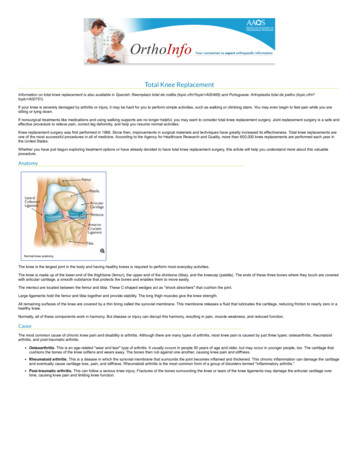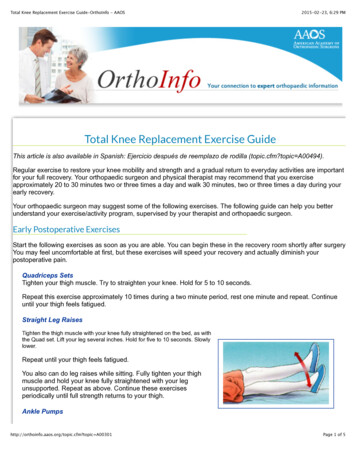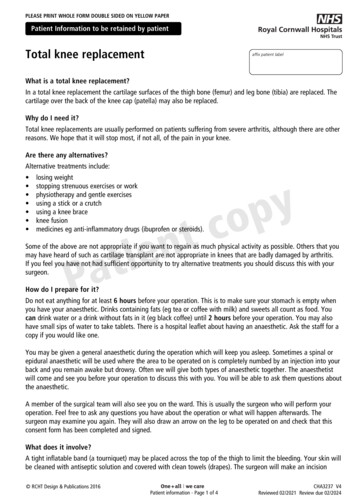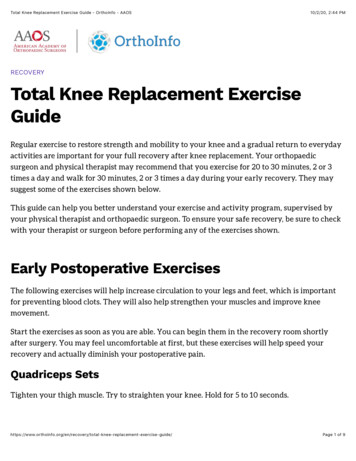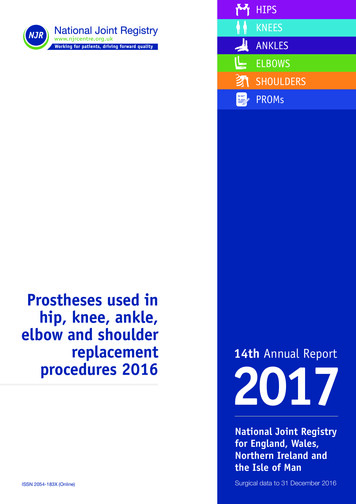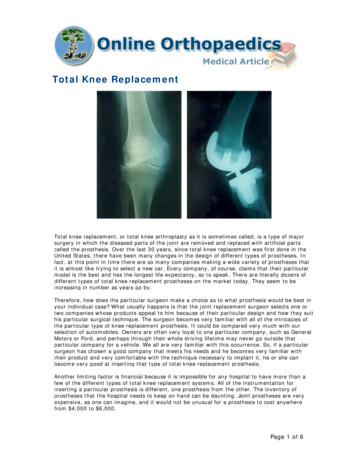
Transcription
Total Knee ReplacementTotal knee replacement, or total knee arthroplasty as it is sometimes called, is a type of majorsurgery in which the diseased parts of the joint are removed and replaced with artificial partscalled the prosthesis. Over the last 30 years, since total knee replacement was first done in theUnited States, there have been many changes in the design of different types of prostheses. Infact, at this point in time there are so many companies making a wide variety of prostheses thatit is almost like trying to select a new car. Every company, of course, claims that their particularmodel is the best and has the longest life expectancy, so to speak. There are literally dozens ofdifferent types of total knee replacement prostheses on the market today. They seem to beincreasing in number as years go by.Therefore, how does the particular surgeon make a choice as to what prosthesis would be best inyour individual case? What usually happens is that the joint replacement surgeon selects one ortwo companies whose products appeal to him because of their particular design and how they suithis particular surgical technique. The surgeon becomes very familiar with all of the intricacies ofthe particular type of knee replacement prosthesis. It could be compared very much with ourselection of automobiles. Owners are often very loyal to one particular company, such as GeneralMotors or Ford, and perhaps through their whole driving lifetime may never go outside thatparticular company for a vehicle. We all are very familiar with this occurrence. So, if a particularsurgeon has chosen a good company that meets his needs and he becomes very familiar withtheir product and very comfortable with the technique necessary to implant it, he or she canbecome very good at inserting that type of total knee replacement prosthesis.Another limiting factor is financial because it is impossible for any hospital to have more than afew of the different types of total knee replacement systems. All of the instrumentation forinserting a particular prosthesis is different, one prosthesis from the other. The inventory ofprostheses that the hospital needs to keep on hand can be daunting. Joint prostheses are veryexpensive, as one can imagine, and it would not be unusual for a prosthesis to cost anywherefrom 4,000 to 6,000.Page 1 of 6
Major advancements in total knee replacements over the past 25 to 30 years have offeredpatients with severe knee joint pain the ability to lead a reasonable full and active life withminimal or no pain in the affected knee joint.A replacement prosthesis for the knee joint includes a rounded, somewhat U-shaped part that fitsover the end of the femur or the upper part of the joint. A flatter piece, which is also metal likethe upper portion, is placed on the lower aspect of the knee joint and this has a stem that fitsdown into the bone. A very special type of polyethylene plastic is inserted between the two metalportions of the new knee joint. This keeps the metal portions from touching and is the middlecomponent of the system. In most cases, the surface of the patella or knee cap is also replacedwith a polyethylene piece.It would be a mistake to think that a replacement knee joint is ever as good as a normal kneejoint. You have to follow directions and take good care of it for it to be able to do a good job foryou for as long as you will need it. We find that those patients who are able to strengthen theoperated leg adequately and take proper care of the new knee joint do the best over a longperiod of time. The prosthesis is an amazing solution to knee pain that has stood the test of time,but it still cannot withstand the same amount of force as a normal knee joint.One of the most important things for a patient to remember about having knee replacementsurgery is that you will be making a commitment to work extremely hard to restore fullstraightening of the knee as well as bending the knee back to a right angle or 90 degrees. Thepatient will need to work very hard on strengthening the muscles on the operated leg as this iswhat makes the total knee replacement work. To have a total knee replacement and veryinadequate muscles in the operated leg is much like having a new car with no motor in it. Itfrequently takes 6-12 months for the person to really be able to restore full strength andfunctioning to the operated lower extremity. Some patients of course, will be able to do thissooner than others. It also depends a lot on a patient's overall condition before surgery takesplace.When a person decides it’s time to have a total knee replacement, it is extremely important tobecome an active participant in his or her own care. We welcome patient's questions and feel thatthe person is entitled to know what alternative treatments may be available to them. Falseexpectations about recovery and life after surgery can cause frustration and disappointment andaffect the progress of recovery and rehabilitation.A walker or two crutches are always required after a total knee replacement and are used for atleast a month, and possibly longer, after the surgery is performed.Joint replacement surgery has been successful in more than 9 out of 10 people.Complications can and do develop after knee replacement surgery and include infection and bloodclots, to name two of the most serious. Fortunately they only occur in a small number of patients,but to be well informed a patient must be aware of these things as possibilities.We encourage patients to increase activities as able based primarily on muscle tone. It is usuallythree or four months before a person can resume low impact aerobic activities such as walking,golfing, bowling and swimming. Jogging and high impact activity sports are never permitted. Thenew knee joint is artificial and although it is made of very durable materials, it can be subjectedto wear and tear changes.Total knee replacement certainly has stood the test of time and is one of the more commonprocedures that we do. Some of our most grateful patients have been total knee replacementpatients. Joint replacement surgery is one of the most gratifying procedures that we do, both forPage 2 of 6
the patients and for myself as a joint replacement surgeon. With continued advancements ofsurgical techniques and materials, the future should hold even greater promise than the present.Partial Knee ReplacementPartial replacement of the knee joint is often referred to as unicompartmental or unicondylar kneearthroplasty. In 2001 about 10 thousand unicompartmental knee arthroplasties were performedin the United States.These partial knee replacements have been around for 25 years or more. It has however onlybeen in the last few years that procedure has been made less invasive.As most patients know, traditional knee replacement is done through a fairly long incision in thefront of the knee with a hospital stay of 4 to 5 days and a period of recovery of at least 1 or 2months and sometimes extending to 3 months. A significant part of this time is spent using awalker or crutches.Minimally invasive or partial knee replacement allows the prosthesis to be inserted through asmaller incision and usually with a faster recovery than the complete knee replacementprocedure.The partial knee replacement is not for everybody. Most of our patients with arthritis have diseasein all three of the knee compartments. This partial knee replacement applies only to patients whohave disease in 1 of the knee compartments either the inner or outer aspects of the knee termedmedial or lateral.Additional information can be obtained by patients at the following web iknee/.FAQsQUESTION:How many total knee replacements are done each year?ANSWER:It seems like an awful lot of people are having their knee replaced.About 267,000 total knee replacements are performed in the United States each year.Over the years, we who do total knee replacements have noticed the number of total kneereplacements has greatly outpaced the number of total hip replacements. At this point, mostorthopaedic surgeons who do joint replacements of the knee and the hip, perform about 6 or 7knee replacements for each total hip replacement. This has been my personal experience also.QUESTION:How does a normal knee work?ANSWER:First, it must be stated that a normal knee is not a hinge. The knee is the largest joint in thePage 3 of 6
body. The knee is composed of the thigh bone or femur, which moves on the upper end of theshin bone (tibia) and the knee cap (patella), which moves in a groove on the front of the femur.Very large ligaments called collateral ligaments surround the knee provide stability as do theanterior and posterior cruciate ligaments, which are deep inside the knee.The long thigh muscles give the knee strength. The joint surfaces within the knee are coveredwith articular cartilage, a smooth and tough substance that cushions the bones and enables themto move easily on one another.The lining of the knee joint also called the synovial membrane, produces joint fluid that lubricatesthe knee and reduces friction in a healthy knee to less friction than on wet ice.The meniscus, or joint cartilage as patients call them, are gristle like discs or wedges that helpstabilize the knee and also keep the bone of the femur and tibia separated.The knee is not a hinge. Although it does bend through a range of motion sometimes reaching140 degrees, it also slides one surface on the other and rotates significantly.The knee's function is extremely complicated compared with the more simple ball and socketrelationship of the hip.QUESTION:How long do I have to stay in the hospital after knee replacement surgery?ANSWER:It varies quite a lot in my experience, and it is only possible to give some generalizations. I havehad some patients go home as early as the third day after surgery. I would say the average is 4days in patients under 65, and I find that older patients frequently need to go to the rehabsection of the hospital where they might spend up to an additional week regaining strength andrange of motion in the operated knee.The less invasive surgery technique that I try to use in all of our patients has made a bigdifference in how quickly people are able to go home.QUESTION:I have heard that blood clots can occur after total knee replacement surgery. What doyou do to prevent them?ANSWER:Blood clots in the legs can occur following total knee replacements and are a very seriouscomplication. The medical name for this condition is deep vein thrombosis. It can occur either inthe operated leg or the non-operated leg.There has been an increasing awareness of this problem in recent years.This is what I personally do to try to prevent and or reduce the complication of blood clots:I try to keep the foot of the bed elevated postoperatively at all times for several days. Elasticsupport stockings are worn by the patient and a pumping device is used on both lowerextremities from the ankles to the thigh, which intermittently compresses the legs to move bloodPage 4 of 6
along and prevent pooling. Coumadin, a blood thinner, is given on the night of surgery for thefirst time and is continued for 30 days after surgery.I get the person up walking as soon as possible, which helps reduce the incidence of blood clots.Continuous passive motion machine (CPM) is used to help decrease leg swelling by elevating theleg and improving venous circulation by moving the muscles of the leg.We also instruct patients to move the feet and ankles immediately after surgery to increase bloodflow in the leg muscles and prevent swelling and blood clots.QUESTION:When will I be able to drive a car after total knee surgery?ANSWER:Most of my patients resume driving about 4 to 6 weeks after surgery. At this time, the knee isbending sufficiently so the patient can enter and sit comfortably in the car and control of themuscles is sufficient to allow for movement of the knee and the lower extremity for operating thevehicle.QUESTION:Do I need to take antibiotics after total knee replacement when I go to the dentist?ANSWER:The most common cause of infection following total knee replacement surgery is from bacteria inthe blood stream that might enter the body during dental procedures, urinary tract procedures, orthrough skin infections.These bacteria, carried to the knee in the blood stream, can lodge around the knee prosthesisand cause infection to begin in the joint.My policy is that following total knee replacement surgery the patient should take antibioticsbefore dental work or any surgical procedure that could allow bacteria to enter the blood stream.This should be done for the rest of the patient's life.Page 5 of 6
Page 6 of 6
Total Knee Replacement Total knee replacement, or total knee arthroplasty as it is sometimes called, is a type of major surgery in which the diseased parts of the joint are removed and replaced with artificial parts called the prosthesis. Over the last 30 years, since total knee replacement was first done in the United States, there have been many changes in the design of different types of .
